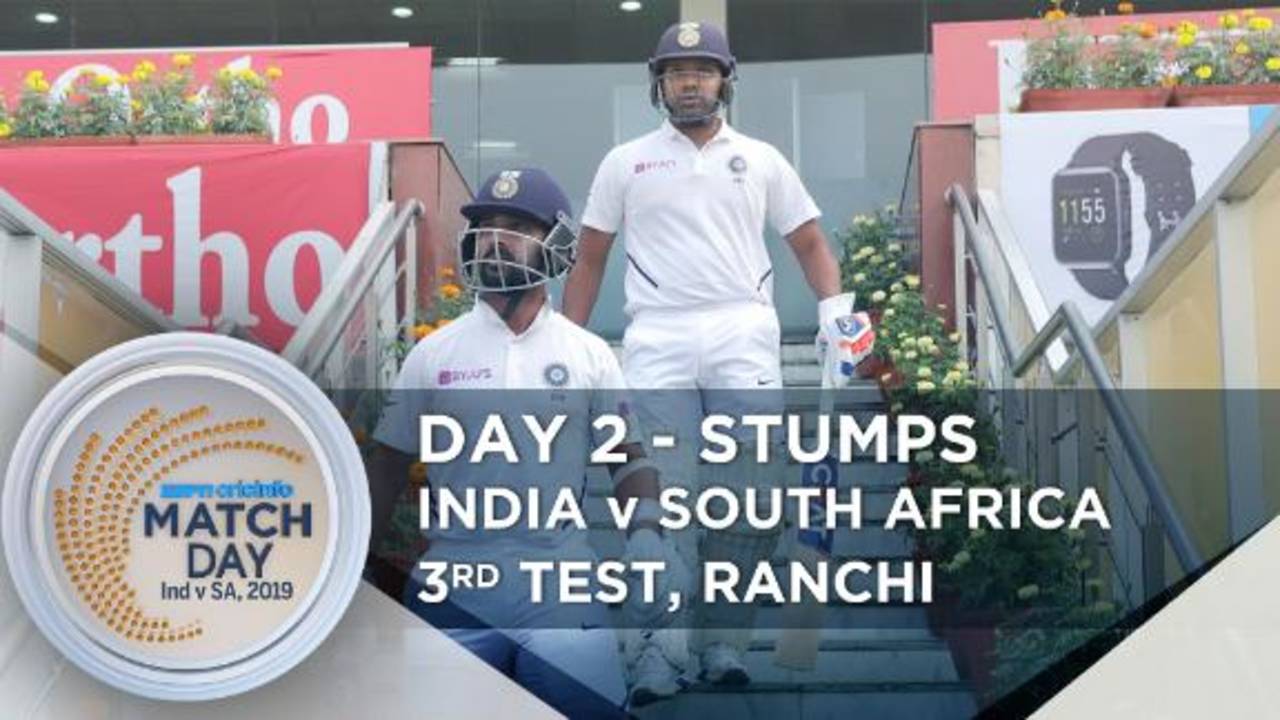Umesh Yadav and Mohammed Shami revel in toss advantage
Umesh and Shami extracted more from the surface than SA, but the cushion of runs and lack of time meant they could go full tilt
Karthik Krishnaswamy in Ranchi
20-Oct-2019
Thirty-nine for 3 in 20 overs; 36 for 3 in 15; and today, 9 for 2 in five.
Whether it's been Visakhapatnam, Pune or Ranchi, South Africa have ended the second day's play in pretty much the same situation. Each time, having fielded for upwards of 115 overs, their top-order batsmen have gone in to face a fresh set of India bowlers.
These bowlers, meanwhile, have known each time that they would only be required to bowl a handful of overs before resting overnight and coming back with a still relatively new ball.
Déjà vu. All over again. And again.
In Pune, Mohammed Shami and Umesh Yadav seemed to bowl with an incredible level of intensity in the final hour of day two, galloping in and hitting the pitch with venom. They did the same again in Ranchi, bowling just the one over each, in fading light, and removing an opener each with snarling lifters.
Watch cricket on ESPN+
India v South Africa is available in the US on Hotstar and ESPN+. Subscribe to ESPN+ and tune in to the Ranchi Test.
Watching those spells, you might have wondered why South Africa's fast bowlers - even Kagiso Rabada, as good as he has been in some of his spells - haven't managed to summon up the same level of nastiness.
There are many reasons for this.
Firstly, in all three Tests, India have declared and left themselves just enough time to bowl on the second evening to ensure they still have a new-ish ball at the start of day three. Each time, their fast bowlers have known that only a short, sharp burst of effort would be required of them before they could rest, and come back for another short, sharp burst. Each time, their fast bowlers have had the cushion of big runs behind them, and could, therefore, afford to attack the batsmen without fearing the consequences of leaking a few early boundaries. We're talking here of attacking with the ball, and not just with the field.
South Africa, on the other hand, have had to bowl on the first morning of all three Test matches, knowing they would probably have to be on the field for the entire day, if not longer. In that situation, fast bowlers can't just go full-tilt. By definition, new-ball bowlers on the first morning have to aspire for a certain degree of control.
Secondly, India's fast bowlers know they will mostly have to bowl only in short spells. India can bank on their spinners to control the game for long periods, while posing a considerable attacking threat themselves, while the quicks rest and recuperate between spells.

Umesh Yadav bounced out Quinton de Kock•BCCI
South Africa's fast bowlers can't trust their spinners in the same way.
And the two sets of fast bowlers have had to endure very different workloads. Rabada and Shami are the only two quicks to feature in all three Tests so far. Before the third Test began, Rabada had bowled 67 overs, and Shami 54.5.
Rabada had bowled his overs across three innings, and Shami across four, but that isn't a huge difference necessarily, because India enforced the follow-on in Pune. However, with India batting first each time, Shami has always had an extra day-and-a-half's rest between Tests.
In a series without big gaps between games, all this can add up. And all this has come to pass primarily because India have won all three tosses.
Batting first in India is generally reckoned to be an advantage because the pitches don't offer much seam early on - Pune and Ranchi, however, have offered quite a bit - and are at their best for batting on the first two days, before wear and tear sets in. But, as we've now seen, there are other advantages to batting first too. You have to bat really well to gain these advantages, as India have, but once you do, you can make life a little easier for your bowlers, and much, much harder for the opposition batsmen.
Have India's quicks outbowled South Africa's through this series? Yes, they have. But has the gap really been as wide as these numbers make it seem? Well, probably not.
Karthik Krishnaswamy is a senior sub-editor at ESPNcricinfo
